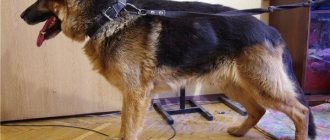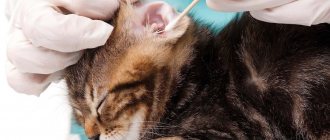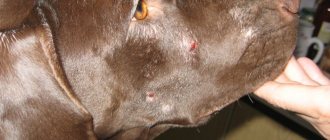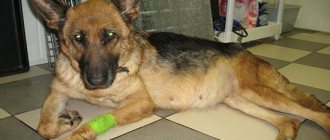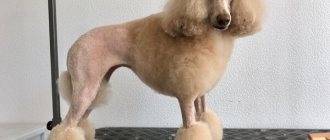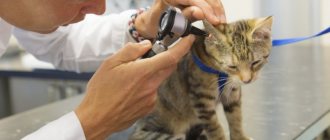Dachshunds are active, cheerful dogs with good health.
However, they are also characterized by some diseases that lead to serious consequences.
Often representatives of this breed have impaired mobility of the limbs, manifested by a change in gait or complete failure of the paws.
Paralysis of the limbs can be caused by various diseases, the symptoms of which all dachshund owners need to know about.
Chronic musculoskeletal problems
Problems with the musculoskeletal system in dachshunds occur quite often, which is due to the specific structure of the skeleton.
Most common diseases:
- discopathy – degenerative disorders leading to disruption of the properties of intervertebral discs;
- Osteoporosis is a pathology that manifests itself in puppies aged 3 weeks to 1.5 months, in which the dog cannot walk, stand on its paws, or roll over.
The development of arthrosis and arthritis is possible.
Breed diseases, their symptoms and treatment
For various reasons, different types of diseases are inherent in different dog sales. The dachshund's body structure, lifestyle, genetic inheritance and a number of other reasons can predispose to the occurrence of diseases. Let's look at the common types of diseases in this breed.
Spinal diseases
The body shape of the dachshund makes this breed especially recognizable. The long back of the dachshund receives a lot of stress. The most common diseases in this breed are diseases of the spine such as:
- osteochondrosis;
- spondylosis;
- discopathy.
Osteochondrosis is an inflammatory disease that affects the cartilage and bones in the joints, which, if left untreated, can affect the pet’s limbs and lead to paralysis.
Symptoms of osteochondrosis usually appear at the age of 3 years and are expressed as follows:
- the dog is especially clumsy in the morning;
- waddles when walking;
- loses balance;
- when walking, shifts the center of gravity to the front paws;
- whines when moving.
Timely seeking qualified help from veterinarians will help your pet regain health and prolong its full motor activity.
Osteochondrosis at the initial stage responds well and fairly quickly to treatment. Advanced stages may require surgery, with a long recovery process, special care, etc.
Spondylosis - the development of the disease is characterized by ossification of the intervertebral discs, which leads to narrowing of the openings and pinched nerves. The passage of impulses becomes difficult or stops completely, which causes organ paralysis, which is caused by a pinched nerve. In this case, the hind or front legs may fail, and what to do with such a disease, read below.
This disease is diagnosed in dachshunds aged eight years and older. Drug treatment can slow down the development of spondylosis; in parallel, veterinarians can prescribe physiotherapeutic procedures.
Osteoporosis in puppies (swimmer's effect)
Osteoporosis of the limbs in dachshund puppies can appear at the age of 3–4 weeks. Motor movements in babies are difficult and they do not stand up on their paws; when they try to stand up, their limbs move apart and the pets end up on their bellies, awkwardly moving their paws, hence the name - swimmer's effect. The disease in most cases is hereditary. Treatment consists of prescribing a course of vitamins.
If you have osteoporosis of the extremities, you should carefully monitor the baby’s nutrition and avoid excess weight. It is necessary to exclude all movements on how many surfaces. The disease responds well to treatment and by 1.5 months of life, pets are moving happily on their paws. This disease is recorded only in representatives of the dachshund breed.
Acanthosis nigricans - skin dystrophy
Acanthosis nigricans or skin dystrophy is a common disease in dachshunds , which in most cases is associated with a disruption in the secretion of steel glands. There are known cases of the disease occurring in animals with disorders of the endocrine system and adrenal glands.
Skin dystrophy is expressed in the formation of compactions, the appearance of additional folds and hyperpigmentation.
Certain areas are affected, such as:
- armpits;
- breast;
- stomach;
- groin;
- inner thighs or ear.
The appearance of dark spots on the skin may be accompanied by severe itching.
Important ! It is necessary to exclude the possibility of the pet scratching the affected areas in order to avoid complications.
Acanthosis nigricans has three subtypes, and the dog’s further condition will depend on the correct treatment:
- Primary acanthosis nigricans completely incurable. If the disease does not spread, then special shampoos are used. As the disease progresses, the veterinarian may prescribe:
- hormonal;
- antihistamines;
- sedatives.
- Secondary acanthosis is completely cured after eliminating the main cause of the disease.
- Pseudoacanthosis is similar in appearance to classic acanthosis nigricans and appears against the background of allergies, dermatitis, obesity and hormonal imbalances.
Discopathy
Discopathy is a pathology of the tissues of the intervertebral discs , which lose their elasticity, change shape and become deformed. During the course of the disease, the dachshund may experience paralysis or cuts without loss of sensation.
Early diagnosis of the disease and conservative treatment can stop the destructive process. In later stages of the disease, the dog experiences a displacement of the fibrous ring towards the spinal canal, which disrupts the functioning of the spinal cord. Severe forms of discopathy can lead the animal to serious disorders of the musculoskeletal system.
The development of discopathy occurs in different ways and the disease may not manifest itself for a long time. It is necessary to show your pet to a neurologist to establish the causes or timely detection of pathology if the animal has:
- difficulty moving;
- soreness;
- dragging or falling on paws without injury;
- uncertainty when walking.
Treatment of discopathy directly depends on the severity of the disease:
- At the initial stage, drug treatment is used to slow down the course of the disease; unfortunately, there are no drugs that can completely cure a dog. By following all the recommendations of the attending physician, the pet will be able to lead a full life.
- For severe disc damage, surgical intervention and subsequent drug treatment are recommended. The recovery period will require time and special requirements for caring for the dachshund; physical treatment, rest and diet will be prescribed.
Diseases of the ears and eyes
A sure sign of any ear disease in dogs is:
- head shaking;
- ear scratching;
- discharge or plaque on the ears.
The causes of diseases are different, as are the diseases themselves:
- Otitis, the cause of the disease can be:
- allergies;
infections;
- mites;
- fungi;
- injuries.
- Inflammation of the outer ear . The disease develops against the background of hypothermia, due to water entering the auricle, covered by the elongated ear of the dachshund. Characterized by the development of slight edema and purulent discharge. If untreated, an infection may enter the middle ear and develop a more severe form with inflammation of the middle ear, which can spread to neighboring organs. In a dog with such inflammation, any movements of the mouth may be painful, purulent discharge appears not only from the ears, but also from the eyes . You should immediately seek medical help from a veterinarian to avoid complications such as meningitis or vestibular disorders.
The disease manifests itself with severe itching and discharge from the ears.
Important ! When a doctor prescribes local medications in the form of drops, gels and ointments, treatment should be carried out on both ears.
Among representatives of dachshunds, eye diseases are often recorded, such as:
- glaucoma;
- cataract;
- retinal atrophy;
- optic nerve atrophy.
- Cataracts in dachshunds have a genetic predisposition and occur with age - in dogs over 5 years old and juvenile dogs aged from 3 months to 3 years.
- Glaucoma is a violation of the outflow of fluid from the chambers of the eye, which leads to an increase in eye pressure, and as a result, retinal detachment develops. The dachshund's tear production increases, and squint and protrusion of the eyeball may develop.
- Progressive retinal atrophy in dachshunds is rare and usually does not lead to severe forms with vision loss. With retinal atrophy, visual acuity decreases, especially in the dark. The disease develops slowly, and it is not difficult for the owner to notice symptoms of loss of visual acuity.
Epilepsy
True epilepsy in dachshunds is a very rare occurrence. Representatives of this breed have recorded cases of idiopathic epilepsy. Symptoms are: impaired coordination of movements of the hind legs, then the front legs. The attacks are accompanied by vomiting, and body tremors are possible. This condition lasts several minutes and passes without a trace, the dog feels good and active.
There are more serious cases of idiopathic epilepsy with a duration of 3 to 40 minutes. The attacks are accompanied by involuntary urination, trembling of the muscles of the head and neck, curling up in a ball, and the dachshund moaning. After an attack, your pet is thirsty and weak.
Obesity
The weight of an adult dachshund should not exceed 9 kg . Obesity problems in dogs of this breed are primarily related to the owner. Dachshunds are known beggars and, without exercise, they quickly gain weight. Obese dogs are susceptible to diseases of the cardiovascular system, spine and shortness of breath.
To avoid obesity, it is important to monitor your pet’s diet and diet and provide physical activity.
In rare cases, obesity in dachshunds is associated with diseases of the endocrine system or hormonal imbalances.
Reasons for refusal
Failure of a dachshund's hind legs can be caused by various diseases associated not only with the pet's musculoskeletal system, but also with its internal organs.
It may also be a result of trauma the dog has suffered.
Diseases of the musculoskeletal system
Normal control of the limbs is ensured by the spinal cord, so the slightest disruption of the vertebrae and bone tissue can lead to disruption of the paws..
| Pathology | Description |
| Discopathy | When the vertebral discs are damaged, the disc substance penetrates the spinal cord and intervertebral hernias form, as a result of which the nerve endings are compressed |
| Osteochondrosis | Joint pathology, mineralization and destruction of cartilage. As a result of the disease, not only cartilage can be affected, but also joints and ligaments. With osteochondrosis, the dog drags its paws and limps |
| Arthritis, arthrosis | Joint diseases that often affect not only the hind limbs, but also the front limbs, causing pain in the dog while walking |
| Hip dysplasia | Pathology characterized by destruction or change in the structure of articular tissue. It is rarely diagnosed and is usually a hereditary disease. The first symptoms can be noticed in a puppy at the age of 4 months; over time, the disease develops until the limbs completely fail. |
Injuries
Limb failure can also occur as a result of mechanical damage to the back or paws. Factors leading to spinal injuries most often include blows to the back, falls from heights, being caught in doors, or fights with other animals.
The most dangerous injuries are fractures and tendon ruptures, which cause damage to peripheral nerves, which may require a cast to be placed on the pet’s limbs.
Diseases of internal organs
Impaired coordination of movements and the so-called “drunk gait” most often indicate that the dog is having a stroke.
A dachshund can also lose mobility due to excess weight, when the pet’s body weight significantly exceeds the norm.
In addition, representatives of this breed can form benign tumors - growths on the bones of the limbs, which over time spread, including to the spine.
This affects the animal's mobility, causing pain while walking..
Paw growths rarely lead to paw failure, but the pet begins to move much less, which can lead to obesity and other health problems.
Expert opinion
Tolkachev Andrey Mikhailovich
veterinarian
Due to the propensity of representatives of this breed to diseases of the musculoskeletal system, it is necessary to carry out preventive measures aimed at minimizing the risk of such diseases. Unfortunately, problems with the spine and motor activity of the limbs can appear as a result of injuries and hereditary diseases, which are almost impossible to predict. It is necessary to take the dog to the veterinarian as soon as changes in its behavior are noticed, even remotely indicating possible limb failure.
Symptoms
Yesterday the animal was running and barking, but today it lies and does not get up, does not even move - this does not happen. If a dachshund's hind legs fail, this can be noticed before the onset of complete paralysis. This is evidenced by the following symptoms:
- Slow gait, accompanied by lameness.
- The animal does not react if its tail is pinched or pulled. The dachshund simply lost sensitivity in this area.
- Problems with urination and bowel movements have appeared - these processes are uncontrollable.
- When trying to pet or pick up, the pet whines or snarls.
- The dachshund lies and hardly moves its paws, does not try to get up, even if it is offered something tasty.
- In case of injury, hematoma, swelling, and severe pain are possible.
- If this is a benign tumor, then changes will occur in the pet’s behavior - lethargic, inactive, plays less, eats little.
All these symptoms can tell the owner that the dachshund’s hind legs have failed. You need to look for the problem and start treatment immediately. An experienced veterinary center specialist will tell you what to do and what to do with your dog.
Symptoms in a pet
The following symptoms may indicate limb failure in your pet::
- involuntary urination;
- pain;
- lameness;
- weakness;
- inability to move paws;
- swelling;
- possible manifestation of aggression;
- loss of pain sensitivity.
It is necessary to know about the symptoms - this will allow you to contact a specialist in a timely manner, establish a diagnosis and determine a treatment regimen.
Harbingers of paw failure
Signs that indicate the possibility of paw failure depend on the cause . With discopathy, for example, at the early stage of the disease there are no external manifestations; most often the dachshund begins to worry when the disc is already deformed and displaced.
With intervertebral hernia, diseases of internal organs, pathologies of the spine and musculoskeletal system, the pet whines, does not find a place for itself, and may bite when trying to pick it up.
His motor activity is sharply limited, his stomach is tense, and his back seems hunchbacked and is fixed in this position.
In case of mechanical damage, swelling of the damaged area and the formation of hematomas are observed..
Reasons for refusal in puppyhood
Paw failure in puppies is most often caused by mechanical damage or progressive osteoporosis.
NOTE!
Only a veterinarian can determine the exact cause, based on the results of the examination.
After the diagnosis is made, the necessary treatment will be prescribed and a diet and training plan for the pet will be drawn up.
Diagnostic measures
First of all, the veterinarian conducts a neurological examination, the purpose of which is to determine the degree of sensory loss or to identify its preservation.
For an accurate diagnosis, it will be necessary to carry out:
- urine and blood tests;
- magnetic resonance imaging;
- computed tomography;
- Ultrasound of internal organs;
- X-ray examination using a contrast agent (myelography).
It is impossible to detect intervertebral hernia using myelography.
Diagnostic methods
The veterinarian’s decision on how to treat the dachshund is made after examining the dog’s condition. A preliminary neurological examination is carried out to determine the preservation or detection of loss of sensitivity in certain areas of the pet’s body.
To identify the cause of the disease, the veterinarian examines the dog and prescribes an examination.
Accurate diagnosis of a dog’s health includes examination using MRI, myelography or CT. Before being examined by a doctor (there are signs of pain in the pet), it is permissible to take weak painkillers - Baralgin or Analgin.
Important. X-ray examination will not be able to detect disc herniation in an animal.
How to avoid problems during puppyhood
You can minimize the risk of limb problems in puppies by following some care rules:
- The pet must not stand on its hind legs, sit in an upright position, go up and down stairs, or jump from a height;
- you need to make sure that there is a flat, non-slip surface where the puppy plays;
- the diet should include cottage cheese and other fermented milk products;
- It is necessary to give your pet supplements containing calcium, glucosamine and chondroitin.
Regular walks and moderate physical activity are also necessary.
Treatment regimen
| Cause of hind leg failure | Treatment |
| Discopathy | At the initial stage of the disease, conservative treatment is used, which involves wearing a corset, pain relief, relieving swelling, restoring blood circulation, taking anti-inflammatory, hormonal and antibacterial drugs. At an advanced stage of the disease, surgery will be required |
| Osteochondrosis | It is necessary to use anti-inflammatory and decongestant drugs, vitamins, as well as drugs that improve blood flow. Physiotherapy and massage are prescribed as an addition to treatment; it is possible to undergo a course of acupuncture and osteopathy |
| Arthrosis | First of all, treatment consists of ensuring the pet's rest and almost complete exclusion of physical activity. As a rule, the medications prescribed are Brufen, Vedaprofen, Voltaren and Gamavit, as well as chondoprotectors that help restore cartilage and joints. In later stages of the disease, surgery is recommended |
| Arthritis | If the animal is not in pain, herbs such as hawthorn and nettle can be used to relieve inflammation. Speaking of medications, these are anti-inflammatory and painkillers (Metacam, Rimodil, Chondroprotector, Traumeel). In case of a traumatic disease or a serious exacerbation, surgical intervention is required |
| Hip dysplasia | If pathology is detected at an early stage, the veterinarian prescribes chondroprotectors and painkillers, recommends adhering to a special diet, limiting physical activity and undergoing a course of physical therapy. At a later stage, surgery is required |
| Stroke | Long-term complex therapy is required, including the use of drugs that increase blood circulation (to restore the nervous system) and vitamin complexes |
| Benign tumors | Surgery will be required |
| Obesity | A strict diet is required, during which the pet should be given vitamins and mineral supplements, as well as medications prescribed by a veterinarian |
| Injuries | Treatment depends on the nature of the damage. This may include the use of fixing bandages, physical therapy and painkillers (for bruises, sprains and closed fractures) or realignment of joints (for dislocations). Serious injuries require surgery |
How to treat?
The treatment regimen depends on the diagnosis and the stage at which the disease is located. If a taxi driver's paws fail, the doctor prescribes drug therapy or surgery, after which rehabilitation of the animal and supportive procedures are necessary. At the initial stage of the disease, when the dog’s limb functionality is just beginning to decline, massage, swimming and special gymnastics are used.
Massage
At the first symptoms of leg weakness, the doctor prescribes a massage for the taxi driver. It is done in a clinic or independently.
At home they act according to the following scheme:
- Prepare the place by covering it with a warm blanket.
- They put a dog on it.
- Lightly stroke the entire body of the animal.
- After massaging the body, move on to the hind legs.
- Take the paw in your hand and stroke it from top to bottom.
- Several flexions and extensions are performed.
- Make circular movements inward two or three times, and then outward.
- Rub the muscles with the thumb, index and middle fingers.
- Massage the pads.
- Repeat the process with the second limb.
- The massage ends with general stroking.
The procedure is effective not only at the initial stage of the disease, but also during the rehabilitation period after surgery.
Swimming and gymnastics
Gymnastics allows you to restore the dog’s motor functions. To do this, the paws are alternately bent and unbent. As a result, muscles and joints develop and begin to move.
Swimming helps strengthen the musculoskeletal system and reduces the risk that your legs will fail to a minimum. A standard bath is quite suitable for water treatments. During swimming, they are supported under the stomach.
Treatment with drugs
Drug therapy is prescribed after a diagnosis has been made and the reason why the dachshund’s paws have failed has been found. Most often, the treatment regimen includes painkillers, anti-inflammatory, decongestant drugs, B vitamins, niacin and fish oil.
Surgical therapy
Surgical intervention is carried out only as a last resort, when the legs fail, in case of fractures, diagnosed tumors. Depending on the complexity of the operation, taxis are given local or general anesthesia. After surgery they need rehabilitation.
Prevention measures
To prevent limb failure, it is necessary:
- give your pet chondroprotectors;
- regularly x-ray an animal prone to dysplasia;
- maintain a balanced diet and prevent obesity;
- eliminate the possibility of coldness of the spine;
- Provide your dog with the opportunity to swim regularly.
All preventive measures are aimed at minimizing the risk of hind leg failure, but it cannot be completely avoided.
Treatment at home
To restore paw mobility, you can begin treatment with well-known folk remedies, which will provide additional recovery and support for your pet:
- Massage. Inactivity of muscles leads to their atrophy, so the use of massage helps prevent their reduction in size. Improving microcirculation improves the access of oxygen and nutrients to tissues. The most effective are kneading and stretching.
- Gymnastics. In a lying position, the animal's mobility in the problem area is simulated. It is carried out for the purpose of warming up the muscles.
- Swimming. After filling the bath with water, the owner lowers the pet to force the dachshund to tense its muscles. This therapy helps to minimize pain during movement and restore limb mobility.
Therapy at home should be used only after tests and communication with a veterinarian. As an ambulance, people's councils are ineffective and sometimes even dangerous.
We offer you to watch a short video in which a veterinarian talks about the problem of hind leg failure in dogs.

